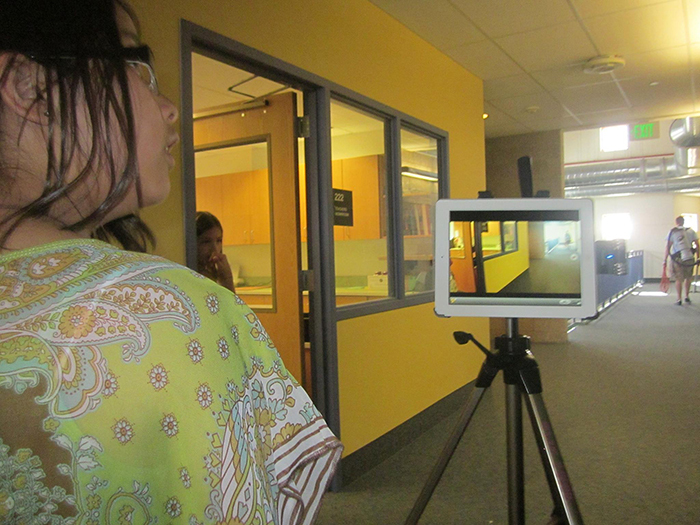A New Spin on Oral Presentations with Tablets and YouTube
I believe that it is important for students to have the ability to express themselves. Working on oral presentations plays a crucial role in helping them to develop this ability. I became disenchanted over time with the traditional ‘one shot, make-it-or-break-it’ way of managing individual presentations for my classes. More recently, I have enlisted the use of tablets and YouTube in my Humanities: Knowledge course as means of capturing my students’ oral presentations and offering them a way to improve their ability to prepare these presentations.
Oral presentations are important for a variety of reasons. They help make students take on a more active role within the courses I teach, instead of simply listening to lectures. I also find that when it comes time to write an essay, the students seem to find it much easier to write about something if they can first talk about it. The presentations can build confidence, and developing persuasiveness is an important skill for their professional lives.

Credit: CC-BY-SA hackNY.org
I’m a product of the new school alternative approach to education. In my high school, we had small classes and were encouraged to explore and be more self-directed. I have to admit that I am a bit nostalgic for those days and wish we could spend a little less time obsessing about preparing students for university, and developing ‘the whole student.’ My own academic experience has tinted my reflection about how I can allow students to become more well-rounded. It is a challenge since class sizes don’t allow us the time to have an approach where we can work with individual students for the entire semester.
Limitations of the Traditional Approach
There are many students in each of my classes, so if we watch each student present their topic, it takes a lot of class time. I also feel that the students listening to the presentations were not benefitting from being exposed to dozens of these presentations. In other words, we were not using class time efficiently. I was also disappointed that I was not able to provide students with immediate feedback on their presentation.
Many of us have noticed that student anxiety is becoming an important problem. While some students are natural speakers, others are very shy and it is painful for them to get in front of the class.
The goal is to be able to express yourself well, in an intelligent, coherent manner. The one-shot approach doesn’t allow students to improve their ability.
Traditionally it was very hard for students to improve their ability with oral presentations, since there is no chance to repeat the presentation. The all-or-nothing approach feeds into the anxiety that the students are experiencing, and in some cases they might completely mess up their grades.
Using iPads and YouTube to Modernize the Approach
In the past few years, the cost of acquiring technology has decreased considerably. In my discussions with our IT Representative, James Sparks, it dawned on me that I could use technology to counter many of the things that I found disappointing in the more traditional approach to oral presentations.
I have been using iPads for about 3 semesters now as part of managing the oral presentations. Instead of providing only one opportunity for students to present, they do 3 separate presentations that are filmed over the semester. Each student chooses which of their 3 presentations will be submitted for evaluation. From a time management perspective, it would be impossible for me to look at each of the 3 videos produced by each student, so having them choose which video will be marked reduces the amount of time I need to invest, and I have adopted a peer-based approach to allow for all the students to have feedback over the semester.

The iPad is a versatile tool for filming oral presentations.
The process begins by dividing the class up into groups of 3 or 4 students, with each group being assigned an iPad. One student presents while another student films them with the iPad. Each student is provided with a different topic to present. They have 1 hour and 40 minutes to work on the filming and can do their presentation again and again until they are happy with the result. The students fan out throughout the college in different locations to film the presentations. At the end of class they submit their iPad to me with their videos, which I then upload to a private YouTube channel that is protected with a password. I allow them to see both their own videos and the videos of others in the class.
If a picture is worth 1000 words, I can tell you that videos are worth even more! Any feedback that I could provide pales in comparison to their ability to see themselves. The idea is that reviewing their video should help them to identify ways of making the next video better, and they have an opportunity to improve their performance in the second round. They can even ask friends or family for a second opinion, and I give them the grading key to see the basis for how they are evaluated.
Tools and Preparation
The students use the native camera application on the iPads which has a video recording feature. They are already familiar with the technology, since it is similar to what they have on their phones.

Credit: Flickr – CC-BY Brad Flickinger
I have thought out all the pedagogy prior to starting the new approach. The trickiest and most crucial thing I have to do is to ensure that I have collected each iPad and know which students are using which tablet. When the iPads come back, I write which students have used each iPad, and am very careful not to mislabel. I make sure that everyone’s content is uploaded. At times there may be technical glitches which mean that the video has not uploaded. In the beginning, I didn’t leave myself enough time to manage the files. It takes a little getting used to, but after 3 semesters, the process is pretty fluid for me.
Student Reaction
I have spoken to a number of the students about whether or not they enjoy the approach to oral presentations used in class. Most of them like it, and I find that the students are generally more successful, with a marked improvement in grades when compared with the traditional approach. It is also a more pleasant and fun experience all around.The tenor and feeling of the class has changed in a positive way. It’s fun to see how the different students approach the presentation, and some have done some real creative things like cutting out illustrations and pasting them on boards. Some even play teacher, using the blackboards as if they were teaching the class as part of their presentations.
There are some students who take shortcuts and who quickly learn that they need to make an effort to improve their grades. It is clear in certain videos that 1 or 2 students have Googled their presentation and are reading directly from Wikipedia. This gives us an opportunity to address academic honesty. I find the medium and advanced students get the most out of the process of filming the 3 presentations as they are more motivated to improve.
Benefits for Students
This approach offers a number of benefits. Unlike traditional oral presentations, students actually get a chance to see themselves presenting. As part of the course, I provide a short workshop on constructive criticism, and filming themselves allows them to critique their own performances. For students who are a little less structured, it is beneficial for them to see good examples of oral presentations from their peers, which helps them to better structure their own presentations.
Given that the students work in groups to film each presentation and provide feedback, I would say that an important benefit of this approach is the increased cooperation and camaraderie that develops over the semester. It is great to see them coach each other and help each other out. I try to choose my groups carefully to have different levels of students with compatible personalities. The 3 oral presentation approach also significantly reduces the anxiety for my most anxious students.
Moving Forward
For any teachers that are thinking about adopting this approach, give yourself plenty of time to figure things out, and try to have some support close by in the beginning, just in case you run into technical snags.
Next semester I am going to try a few minor changes to my process. I will not be sending the link to their oral presentation videos until I assign the following oral presentation. I think that this will allow them to watch their video just prior to starting the next presentation and have a greater impact. I also provide a list of sources to use for their first 2 presentations and have left the third topic wide open for them to choose in the past, but found that a number of my students weren’t choosing good sources. I will be evaluating how to improve this situation. At this point I am only using the 3 oral presentation approach in my Humanties: Knowledge class, but hope to integrate it into my Humanities: World Views course as well.
All in all, I am very satisfied with the overall improvement of the oral presentations coming from my students and will continue to offer them the ability and time to improve throughout the semester. I am always looking for good examples of presentations and video of people engaged in intellectual discussions to help them understand the level of presentation that I am looking for when evaluating them.

